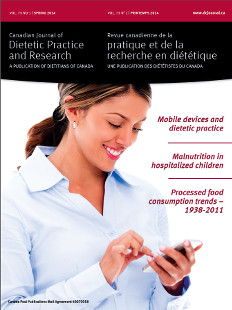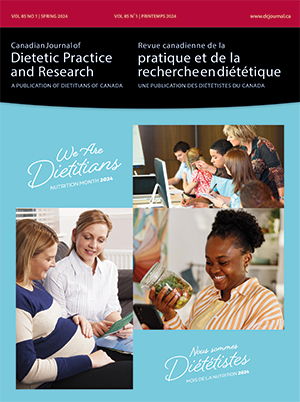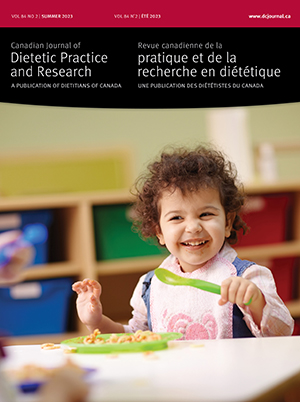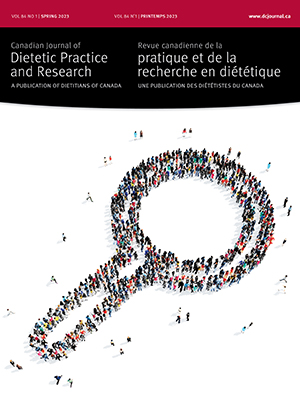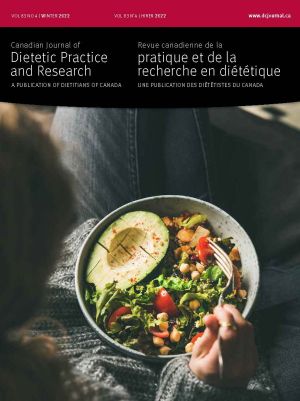Volume 75 • Number 1 • March 2014
Chair’s Message
Editor’s Message
Research
Purpose The extent to which dietitians agreed or disagreed with key informants’ perceptions of precepting knowledge, skills, and attitudes (KSA), training needs, and barriers was determined. Methods A 98-item survey was developed and distributed electronically to Dietitians of Canada members (n=5376). Results Of the 750 respondents who completed the survey (14% response rate), more than 95% agreed that preceptors should have knowledge of promoting learning and skills acquisition, and of learner assessment and evaluation. More than 90% of respondents agreed that preceptors should have skills in planning, teaching, coaching, research, facilitation, and evaluation. Differences in respondents’ perceptions of preceptor participation in practice-based research differed with years of experience. Respondents with fewer than five years of experience had a higher level of agreement that preceptors should participate in practice-based research than did those with more experience (P<0.05). Respondents indicated that barriers to precepting training were insufficient time (93%) and work environments not supportive of precepting (64%). Conclusions The findings articulate the KSA, training needs, and barriers to precepting considered significant for dietitian preceptors. The results are important for the advocacy for resources to support the training and development of preceptors, upon whom sustainability of the profession depends.
Purpose A classification of foods based on the nature, extent, and purpose of industrial food processing was used to assess changes in household food expenditures and dietary energy availability between 1938 and 2011 in Canada. Methods Food acquisitions from six household food budget surveys (1938/1939 , 1953, 1969, 1984, 2001, and 2011) were classified into unprocessed or minimally processed foods, processed culinary ingredients, and ready-to-consume processed or ultra-processed products. Contributions of each group to household food expenditures, and to dietary energy availability (kcal per capita) were calculated. Results During the period studied, household expenditures and dietary energy availability fell for both unprocessed or minimally processed foods and culinary ingredients, and rose for ready-to-consume products. The caloric share of foods fell from 34.3% to 25.6% and from 37% to 12.7% for culinary ingredients. The share of ready-to-consume products rose from 28.7% to 61.7%, and the increase was especially noteworthy for those that were ultra-processed. Conclusions The most important factor that has driven changes in Canadian dietary patterns between 1938 and 2011 is the replacement of unprocessed or minimally processed foods and culinary ingredients used in the preparation of dishes and meals; these have been displaced by ready-to-consume ultra-processed products. Nutrition research and practice should incorporate information about food processing into dietary assessments.
Purpose Nutrition information-seeking behaviour was explored among low-income pregnant Maghrebian women living in Montreal. Environmental factors likely to influence nutrition information-seeking behaviour during pregnancy are discussed. Methods Data were collected in face-to-face interviews with 14 primigravid pregnant women recruited via the Montreal Diet Dispensary, a nonprofit agency with the mission of promoting health among low-income pregnant women. Data collection was part of a larger project on pregnant women’s nutrition decision-making. Results Environmental factors likely to influence informationseeking behaviour were identified. They were grouped within two major themes: culture and interactions with individuals from the social environment. The culture theme was divided into three minor themes: eating habits, food beliefs, and religious beliefs. The interactions with individuals from the social environment theme was divided into two minor themes: interactions with health care providers and interactions with family members. Conclusions Understanding the influence of these environmental factors should help registered dietitians tailor communication strategies to pregnant immigrant women’s specific information needs.
Purpose Malnutrition in hospitalized children has been reported since the late 1970s. The prevalence of acute and chronic malnutrition was examined in hospitalized patients in a general pediatric unit, and the impact and management of malnutrition were assessed. Methods The nutritional risk score (NRS) and nutritional status (NS) (weight, height, body mass index, and skinfold thickness) of children aged zero to 18 years were assessed upon hospital admission. Growth and energy intake were monitored every three days until discharge. Results A total of 173 children (median age three years, 88 girls) participated; 79.8% had a moderate to severe NRS and 13.3% were acutely and/or chronically malnourished. A high NRS was associated with a longer hospital stay in children older than three years (P<0.05), while a poor NS (weight for height percentile) was correlated with prolonged hospitalization in children aged three years or younger (P<0.05). Although weight did not change during hospitalization, a decrease in skinfolds was documented (n=43, P<0.05). Patients with a high NRS had lower energy intake than those not at risk. However, children with abnormal NS received 92.5% of recommended energy intake. Conclusions This study suggests that all children admitted to hospital should have an evaluation of their NRS and NS, so that they can receive appropriate nutrition interventions provided by a multidisciplinary nutrition team.
Purpose In longitudinal studies, parents are the most accurate source of information on young children’s dietary intake; for older children, questioning children themselves may be more appropriate. However, if parental reports for young children and self-reports of older children are to be used in the same analyses, the measures must be comparable. Methods During school hours, fourth and sixth graders in 14 Flemish (Belgium) primary schools completed an online 15- item food frequency questionnaire with a retest questionnaire one to two weeks later; parents completed a paper-and-pencil or online questionnaire. Test-retest data were available for 286 children; children’s tests could be matched to parents’ reports for 275 children. Results On average, test-retest correlations were 0.68 (grade 4: 0.63; grade 6: 0.71) and correlations between children’s and parents’ reports were 0.44 (grade 4: 0.39; grade 6: 0.49). No systematic differences were found between the test and retest. Comparison of children’s and parents’ reports resulted in significant differences for six of the 15 items. Conclusions Low consensus between parents’ and children’s reports for several items may impede comparisons at a group level. Additionally, the results indicate more optimal dietary assessment in sixth graders.
Purpose A cross-sectional web-based survey of dietitians was used to explore topics related to mobile devices and their applications (apps) in Canadian dietetic practice. Methods A survey was drafted, posted on SurveyMonkey, and pretested with dietitians and dietetic interns. Dietitians of Canada (DC), a supporter of this work, promoted the survey to members through its monthly electronic newsletters from January 2012 to April 2012. Results Of 139 dietitians who answered some survey questions, 118 finished the survey; this represents a response rate of approximately 3%. Overall, 57.3% of respondents reported app use in practice, and 54.2% had a client ask about or use a nutrition/food app. About 40.5% of respondents had recommended nutrition/food apps to clients. Respondents were enthusiastic about apps, but many described challenges with use. From the survey data, three themes emerged that can affect dietitians’ use of apps and whether they recommend apps to clients: mobile device and app factors (access to information/ tools, content quality, usability, accessibility/compatibility, and cost), personal factors (knowledge, interest, suitability, and willingness/ability to pay), and workplace factors. Conclusions Apps are now infiltrating dietetic practice. Several factors can affect dietitians’ use of apps and whether they recommend them to clients. These findings will help guide future development and use of apps in practice.
Purpose The theory of planned behaviour was used to explore the factors (i.e., attitude, subjective norm, and perceived behavioural control) affecting the intention of dietetic internship educators, new dietetic graduates, and dietetic interns to use the nutrition care process (NCP) in their clinical practice. Methods Participants (n=55) were recruited from the Bachelor of Science in Nutrition program at Université Laval. They completed an online quantitative questionnaire assessing their intention to use the NCP in their clinical practice, as well as associated psychosocial factors. Open-ended questions were also used to gain a further understanding of the salient beliefs underlying participants’ intention to use the NCP. Results Intention to use the NCP in practice and associated psychosocial factors were similar and favourable within the three participant groups. Subjective norm and perceived behavioural control were the psychosocial factors that significantly predicted an intention to use the NCP. The most cited perceived barrier to use of the NCP was a lack of knowledge, while the most cited facilitator was training opportunities. Conclusions Our results indicate that successful implementation of the NCP will likely require the development of theoretical and practical training activities for both pre-licensure students and experienced dietitians.


